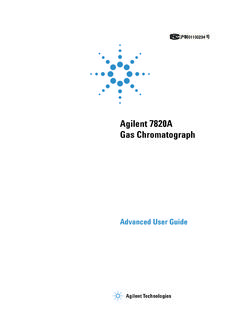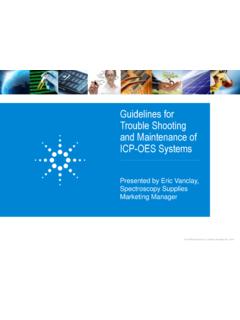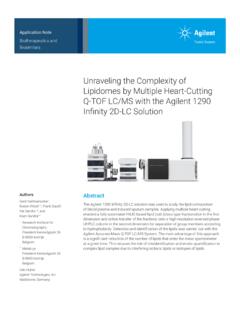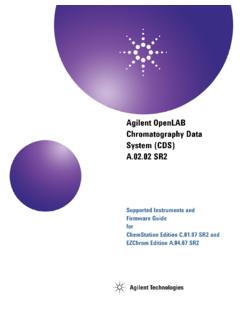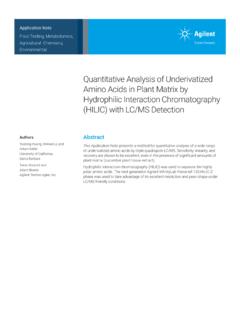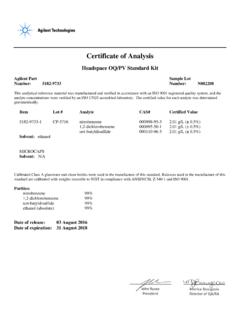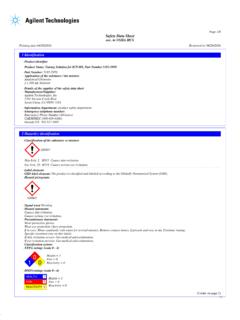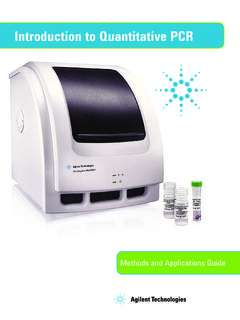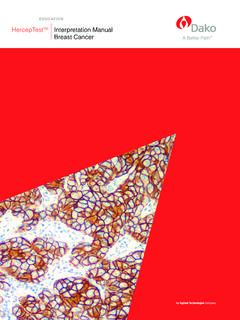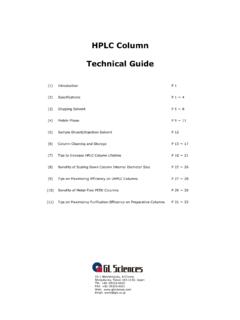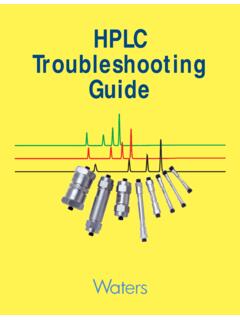Transcription of SUPERCRITICAL FLUID CHROMATOGRAPHY - Agilent
1 SUPERCRITICAL FLUID . CHROMATOGRAPHY . Primer SUPERCRITICAL FLUID . CHROMATOGRAPHY . Primer Terry A. Berger This information is subject to change without notice. Agilent Technologies, Inc., 2015. Printed in the USA, July 1, 2015. 5991-5509EN. CONTENTS. Contents III. Foreword VI. About the Author XI. Introduction XIII. Symbols XIV. Abbreviations XIV. 1 I ntroduction to SUPERCRITICAL FLUID CHROMATOGRAPHY 1. What is SFC? 1. Why deploy SFC? 2. What can SFC separate? 12. What's in a name? 16. 2 The Mobile Phase 19. Why use CO 2? 19. Using 100 % CO 2 21. Modifiers or cosolvents 23. Additives 31. Extending solute polarity with added water 34. 3 The Stationary Phase 35. Materials 35. Achiral bonded phases 35. Stationary phase comparisons 40. Relationship between particle diameter and column dimensions 41. Recommended column dimensions 45. Columns for chiral separations 48. III. 4 E ffect of Mobile Phase Variables on Retention and Selectivity 49.
2 Modifier concentration 49. Temperature 50. Pressure 53. Flow 55. Generalizations on effects of control variables on retention and selectivity 57. 5 Method Development 58. Matching solute and phase polarity 58. Polarity windows 60. Getting started 60. Polar solutes 61. Low polarity solutes 64. Multivariate methods 65. 6 Achiral Separations 66. Case Study 1 A typical low-polarity sample 66. Case study 2 A moderately polar sample 71. Case study 3 Sulfonamides 83. Other observations 89. 7 Chiral Separations 90. Background 90. Enantiomeric excess determinations 91. Normal phase for chiral separations 91. Effect of control variables on chiral separations 93. Developing a chiral method 98. IV. 8 Quantification in SFC 103. Stages of Validation 103. Method development for quantification of sorbate, benzoate, and caffeine in beverages and foods 105. Calibration 108. Summary of the quantification of benzoate, sorbate and caffeine 116.
3 Chiral separations 116. 9 Instrumental Considerations 121. Pumping 121. UV detector optimization 124. The doubling gradient 137. Autosampler considerations 138. Miscellaneous 146. Ultrahigh performance with SFC 148. Hybrid systems switching between SFC and hplc 150. Interfacing to mass spectrometers 154. Other Detectors 156. References 159. V. FOREWORD. The author, Terry Berger has a unique, convoluted history with what we now call SUPERCRITICAL FLUID CHROMATOGRAPHY (SFC), and is uniquely qualified to write this primer. Many of the early interactions were incidental and unfocused, but later meaningful. He brings nearly 40 years of relationships with people associated with SFC, along with over 35 years of direct experience. SFC had first been proposed nearly 60 years ago, in 1958, by Jim Lovelock, who later became a personal friend of the author through the 1980s and 1990s with numerous discussions about SFC.
4 Ernst Klesper demonstrated SFC experimentally in 1962 when he separated metal porphorins with dense clorofluorocarbons as mobile phase. The author later interacted with Professor Klesper on numerous occasions, through the late 1970s to mid-1980s in both the USA and Germany, and again had extensive discussions about SFC. Through the 1960s and 1970s, the technique largely languished with, at most, a dozen groups worldwide making a total of a few sporadic scientific contributions per year. Applications tended to be extensions of gas CHROMATOGRAPHY (GC) to higher molecular weight, higher boiling, relatively nonpolar solutes. In the early 1970s, the author was a graduate student at Purdue University in Indiana. The adjacent laboratory was that of Buck Rodgers, a highly respected chromatographer at the time. After attending a scientific symposium in 1971, he came back determined to explore this new form of CHROMATOGRAPHY .
5 Controlling the pressure of the mobile phase was the primary control variable, and pressure programming from low to high pressures was then the norm. All equipment in this period was homemade, with poor instrumental control. The physical and chemical characteristics of the mobile phases were primitively understood, at best. Rodgers rescued ultrahigh pressure hydrogenation pumps from storage, built an oven roughly 4-feet long that looked like a small coffin using 2-inch thick household foam insulation. Columns were 30 inches long or longer, and packed with irregular particles with a wide particle-size distribution. The author watched the progression of these developments and recalls that, at the time, being skeptical that this odd form of CHROMATOGRAPHY was useful. Rodgers results suggested there was a serious problem with density gradients along the length of VI. the column.
6 This, and later work by Milos Novotney, seemed to indicate that the technique was unlikely to produce results as good as the current high-performance liquid CHROMATOGRAPHY ( hplc ). This tended to suppress further work on packed-column SFC. The author was trained in hplc at Imperial College in London where he developed an amperometric electrochemical detector for hplc , in the early 1970s. After subsequently teaching for a year in Brazil, he worked on a number of projects for instrumentation for spacecraft in Cleveland, Ohio. The author was then hired by Hewlett-Packard in 1979, and joined the research group at the Avondale Division. Dennis Gere, Henk Lauer, Doug McManigill, and Harry Weaver, all scientists or engineers at Hewlett-Packard Labs or the Avondale Division, presented a series of talks on dense gas CHROMATOGRAPHY at that year's Pittsburg Conference (where the author was actually hired).
7 Some of these talks were later published in such journals as analytical Chemistry, and Science, as well as related application notes. These works resulted in a customer demand that led to the creation of a commercial kit that converted a Hewlett Packard model HP 1084 hplc instrument into an SFC system. Thus, commercial SFC was born. This version of SFC used a mechanical backpressure regulator, a binary pump and composition programming, much like hplc . Flow, composition, column temperature, and column outlet pressure were all independently controlled. Unlike previously home-built instruments, there was no pressure programming. Columns were more modern with much of the work done on spherical silica as small as 3 m. The author's group produced the design for this kit. About the same time that a capillary version of SFC, using pressure programming of pure CO2, was introduced, Hewlett-Packard made the HP 1084 instrument obsolete, replacing it with the SFC-incompatible HP 1090 hplc instrument.
8 Milos Novotny and Milton Lee were the drivers behind the capillary SFC development. This author's research group at Hewlett-Packard had just invented fused-silica capillary columns, capable of withstanding the high pressures (400 to 600 bar). necessary for capillary SFC. Milton Lee was an academic leader in the new field of bonding the stationary phase to capillary columns. VII. Packed-column SFC largely disappeared, due to lack of commercially available instrumentation, and capillary SFC was seen as the wave of the future. At this time, the physical chemistry of the fluids and their interaction with the stationary phase were largely unknown. Many controversies erupted pitting the few remaining packed column users against the capillary proponents. The author became the senior research scientist working with SFC at Hewlett-Packard in 1985, and was assigned to unravel these controversies.
9 In the process, he visited every European user (about 16) for extensive discussions about the controversies and potential. At the time, it was widely believed that density was the primary control variable, and that changing the mobile phase density had the biggest effect on retention. It was thought that dense CO2 was as polar as isopropanol, due to an unfortunate misunderstanding by Giddings1. If it were true, adding an alcohol modifier could change density significantly, but only insignificantly change solvent strength. This misinterpretation was not challenged for decades. At the time, there were no direct density measurements of methanol/CO2 (or any other) mixtures used in SFC. Equations of state for binary mixtures were inaccurate. The author subsequently borrowed a densitometer from the University of Delaware and made some of the first density measurements of methanol/CO2 in the literature.
10 He then measured the effect of methanol concentration on retention at constant density, showing that the modifier was indeed responsible for dramatically increasing the elutropic strength of the mobile phase. Not long afterwards, solvatochromic dyes were shown to offer a simple way to measure the strength and polarity of the solvation sphere surrounding the dye molecules in HPLC2. The author then applied the same principle to SFC45. The results indicated that the solvent strength of binary fluids was highly nonlinear, with the first small additions having an inordinate effect. CO2 was shown to be similar to pentane in polarity and solvent strength. With density and solvatochromaic dye measurements, the Giddings'. elutropic series1 was conclusively revised, although it still has followers. The result is that changing modifier concentration was shown to have a much larger impact on retention than pressure, temperature, and density, at least for modified fluids.
